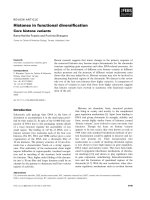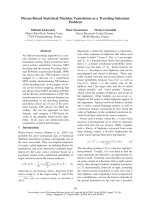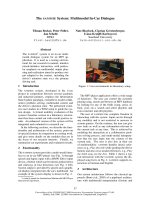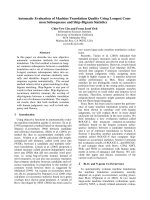Báo cáo khoa học: "Topics in Statistical Machine Translation" potx
Bạn đang xem bản rút gọn của tài liệu. Xem và tải ngay bản đầy đủ của tài liệu tại đây (60.19 KB, 1 trang )
Tutorial Abstracts of ACL-IJCNLP 2009, page 2,
Suntec, Singapore, 2 August 2009.
c
2009 ACL and AFNLP
Topics in Statistical Machine Translation
Kevin Knight
Information Sciences Institute
University of Southern California
Philipp Koehn
School of Informatics
University of Edinburgh
1 Introduction
In the past, we presented tutorials called “Intro-
duction to Statistical Machine Translation”, aimed
at people who know little or nothing about the field
and want to get acquainted with the basic con-
cepts. This tutorial, by contrast, goes more deeply
into selected topics of intense current interest. We
aim at two types of participants:
1. People who understand the basic idea of sta-
tistical machine translation and want to get a
survey of hot-topic current research, in terms
that they can understand.
2. People associated with statistical machine
translation work, who have not had time to
study the most current topics in depth.
We fill the gap between the introductory tutorials
that have gone before and the detailed scientific
papers presented at ACL sessions.
2 Tutorial Outline
Below is our tutorial structure. We showcase the
intuitions behind the algorithms and give exam-
ples of how they work on sample data. Our se-
lection of topics focuses on techniques that deliver
proven gains in translation accuracy, and we sup-
ply empirical results from the literature.
1. QUICK REVIEW (15 minutes)
• Phrase-based and syntax-based MT.
2. ALGORITHMS (45 minutes)
• Efficient decoding for phrase-based and
syntax-based MT (cube pruning, for-
ward/outside costs).
• Minimum-Bayes risk.
• System combination.
3. SCALING TO LARGE DATA (30 minutes)
• Phrase table pruning, storage, suffix ar-
rays.
• Large language models (distributed
LMs, noisy LMs).
4. NEW MODELS (1 hour and 10 minutes)
• New methods for word alignment (be-
yond GIZA++).
• Factored models.
• Maximum entropy models for rule se-
lection and re-ordering.
• Acquisition of syntactic translation
rules.
• Syntax-based language models and
target-language dependencies.
• Lattices for encoding source-language
uncertainties.
5. LEARNING TECHNIQUES (20 minutes)
• Discriminative training (perceptron,
MIRA).
2









